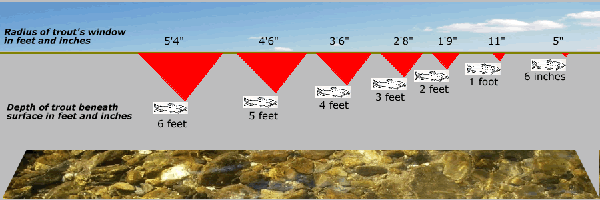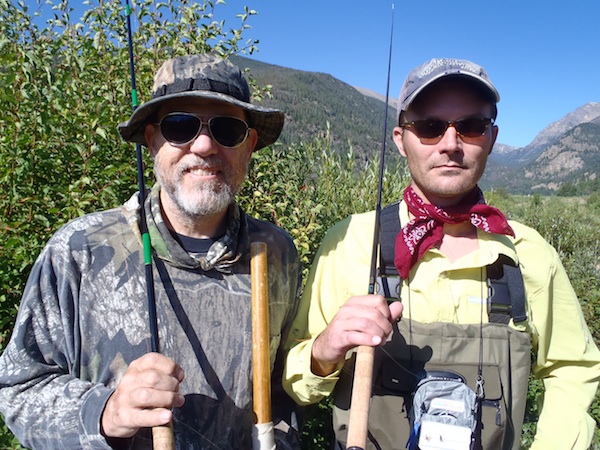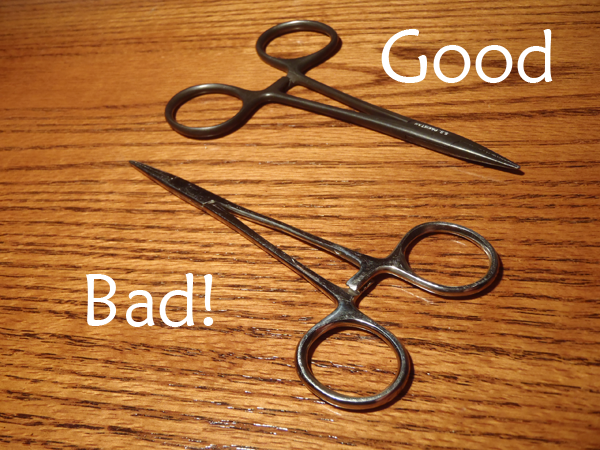It happens to even the most experienced angler. You come across a magazine-perfect pod of trout in crystal clear water. Your eyes become laser focused on them. Anticipation builds. Your adrenaline kicks in. You plot the first and and can almost feel the trout in your hand already. But then, they scatter as if someone threw a bowling ball into the water. What happened?
While trout have fairly poor vision, they are very tuned into their environment. They have to be on constant lookout for anything amiss that might indicate a predator is near. Many anglers might approach a slow, clear pool full or wary trout with trepidation, but there are some things you can do to avoid causing a mass exodus…
1. Blindfold the fish.
Fish have a cone of vision that changes in diameter depending on how deep they are holding in the water. If you’re outside of this cone, then you’re invisible to trout. If you’re in it, they’re gone. While fishing with Dr. Ishigaki (who happens to be a vision specialist), I asked him if he preferred to fish upstream or downstream. His answer was an emphatic upstream. When I asked him why, he said that was the best way to stay out of the cone of vision (because the fish cant see behind themselves). Here is a great diagram from Flyfishing Devon Illustrating this:

But sometimes, you have no option but to fish across stream. In these cases you can lower yourself by kneeling, or by using the next tip.
2. Wear an invisibility cloak.
Hide behind rocks, brush, or other structures that will conceal your presence. Only poke your head out enough to see your target (and do so slowly).
3. Use stealth technology.
Some anglers like Chris Stewart of Tenkara Bum wear camouflage when they fish. While it’s probably not necessary to deck yourself out if full military garb, wearing muted, natural colors will help you blend into the background better while bright colors will make you stick out. I had a friend who always wore a light blue shirt because he thought it would help him blend into the sky (he was a tall guy). I suppose it depends on what type of stream you’re on, but on most of the streams I fish, the trout see me against a background of rock or foliage so darker earth tone colors are better.
Chris Stewart (left) and Jason Klass (right). Whose garb is more likely to spook fish?

Also, use a rod with a matte finish to avoid rod flash. And if you have tools like zingers, forceps, clippers etc. hanging off your vest or chest pack, use matte black ones instead of shiny silver. Always choose dull coated stream tools over shiny ones

4. Fish like a ninja!
It’s just as important to not be heard as to not be seen. Move slowly and be mindful of every footstep. Avoid splashing. If you have metal studs in your wading boots, grinding them over rocks is going to send out a warning signal. Is there a softer, quieter place you can step instead? Move like you’re a teenager sneaking into your bedroom three hours after your curfew.
5. Be a turtle.
In nature, some animals camouflage themselves by moving in slow motion. This works because their surroundings have a natural cadence. Streams flow, branches wave, leaves flutter in the wind. But if something moves faster than that cadence, it is seen as abnormal–a threat. When approaching trout, take it slow (really slow). There’s no rush. The fish will still be there in five minutes (but they won’t be if you come charging in).
6. Mind your doppelgänger.
To a fish, there’s no difference between you and you shadow (or a blue Huron swooping in for the kill for that matter). Always pay attention to where your shadow is being cast. Avoid having the sun directly at your back if possible. Really, you’re paying attention to the position of two anglers–your physical self and your shadow. Both are equally capable of spoiling a nice pool.
With a little mindfulness, you can approach and catch skittish trout in clear water. The key is to become part of the surroundings, rather than being an intruder.









Don’t line your fish. That means don’t cast your line and lay it down right on top of the fish. Keep as much line off of the water as you can. Nothing spooks fish like whacking the water with your flies or line right on top of them.
Hey Jason, Those are great tips. Trout vision is something I have always been interested in. I was once told by a state biologist that a trouts lens actually magnifies the image above and in front of the fish to help them see the tiny midges and other insects they feed on. Oh, and about the drab colors I always wear a green or brown shirt just for that reason. One thing I have found is that if you spook fish just stay still for a few minutes and they will come back. Ive actually had trout bump my feet before. Be like the crane!
Lance, I’ve had the same thing happen. A river a used to fish a ton had trout that would actually behind your boots. It was like they were waiting for me to kick up food, which by the way if you do that, drop a small midge pattern in the mix and you can usually get the fish if you’re that desperate to catch something! And Jason overall fantastic post, never really thought much about color, I always wore a turquoise jacket to be visible to other people. A few places I fish have hunters so I wanted to be visible from a good distance.
Great article and great tips. Going along with the whole shadow aspect, even if it’s not a shadow, but just an outline against a bright sky or something (if you can’t stay out of “the cone”!) Keeping something larger than you behind you like a rock or a tree or a hillside so that the outline doesn’t change is a way to deal with walking right through the cone. My favorite place to fish is downstream from the parking area so I inevitably have to walk past the fish before fishing. I use the hillside to the side and keep a low profile to not stick out like a sore thumb. Love you blog! Keep it coming!
Dear Jason: You are talking about trout, corrrect? Or just fish in general? There is a lot more known about trout vision than what is presented here. In particular, trout can see behind them, after some distance beyond their tail. This is due to the position of the lens and the bulging shape of the external eye surface on trout. The lens actually protrudes beyond the external surface of the head so that is is partially “outside” the eye socket. This position allows light coming from behind the fish to strike the lens, and be bent striking the retina. The trout retina has rods and cones at different locations producing varying clarity. While trout vision from behind might not be sharp enough to distinquish the difference between aquatic insects, it certainly is sufficient to detect movement, angler or otherwise. (I have struggled to explain this and may have failed.)
Yes, I’m only talking about trout. This post was in no way intended to be a comprehensive or scientific article on trout vision. Just some basic tips on not spooking them. Thank you for the additional information. In most cases when fishing upstream, I think the angler is far enough behind the trout to be out of their vision.